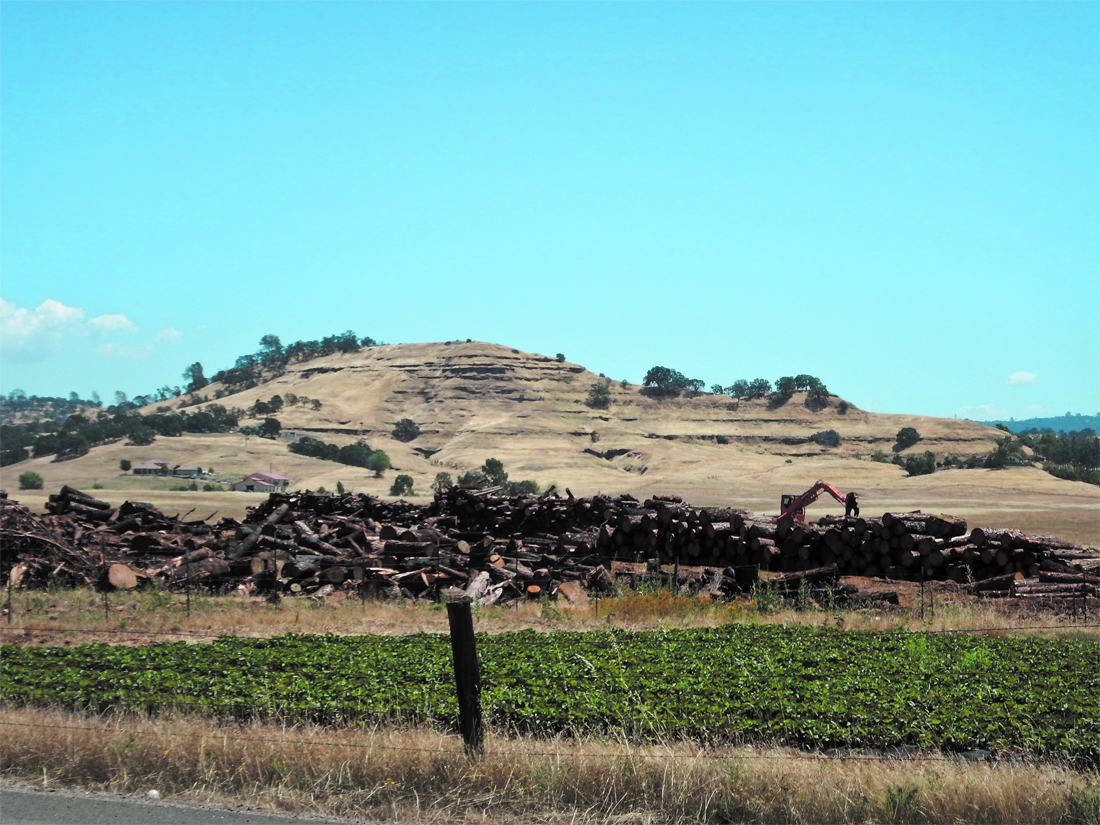
Photo by Meredith J. Cooper
Large-scale lumber yards popped up seemingly overnight. This one is near Butte College.
Sitting at the Clear Creek Crossing gas station on the corner of Durham-Pentz and Clark roads, one can look in any direction and see rolling hills, fields filled with crops, and even the Sutter Buttes on a clear day.
Over the past couple of months, however, that view has changed. Now there are two large-scale lumber yards stacked high with hundreds of logs each. They popped up seemingly out of nowhere, with no warning, prompting an inquiry by Butte County officials, who first addressed the issue at their May 21 meeting and this week came back with a proposed ordinance to govern them.
Turns out, these log decks, or staging sites, are storing trees cut down for PG&E, which plans to clear 91,000 trees from the Camp Fire zone, either because they’re dead or dying or because they pose a threat to future construction. The problem: Neither PG&E nor its contractors ever applied for or received permits for such activity.
Steve Lambert, chair of the Board of Supervisors, has a farm near Clear Creek Crossing and sees the massive operations daily. Among his concerns: Increased fire risk and traffic, and the environment.
“My problem is, we’ve gotta take [the logs] out of Paradise and find a place for them—but we don’t want to create a problem for another region,” he told the CN&R. “Both of those places have creeks—they’re environmentally charged areas—so that is a concern.
“It was convenient for them,” he continued, referring to PG&E. “They popped up clearly overnight. They’re not legal; they’re not even close to being legal.”
Tim Snellings, director of development services for the county, agreed, sharing Lambert’s frustration.
“There should have been better coordination between PG&E and the county,” he told the CN&R. “It was frustrating that they didn’t do that.”
At one point, there were 10 such staging sites—parcels of land PG&E contractors are using to store the tens of thousands of logs en route elsewhere—none of them permitted. Also on-site: offices, heavy equipment used to process the logs, and trucks for hauling them.
Of the two sites near the intersection of Durham-Pentz and Clark roads in unincorporated Butte County, one is zoned for agriculture; the other for commercial, Snellings told the Board of Supervisors at its May 21 meeting.
“I have a problem, personally, with that lack of outreach to the county,” Snellings told the board. “Under our zoning ordinance, the use for processing this type of operation is only allowed in timber management, timber production and heavy industrial zones and it requires a use permit.”
Others were similarly peeved. With a permit comes oversight and accountability. Many of the concerns were environmental: What impacts does this kind of work have on air quality? On stormwater runoff? On dust control? Are these logs that have been taken from the Camp Fire zone considered toxic, increasing risks to the groundwater in agricultural zones?
PG&E spokesman Dan Blair approached the dais to speak to the issue and County Counsel Bruce Alpert addressed him: “Why wasn’t this coordinated?” he asked pointedly. “It’s a simple question.”
“The short answer is that it should have been,” Blair replied. “These log deck operations are managed by our contractors. It’s the expectation of PG&E that, through that contract with PG&E, they [follow] all local, state and federal regulations ….”
The urgency ordinance discussed Tuesday (June 25) will set up rules for the type of land use that PG&E has been employing. With some amendments to staff’s proposal, the board voted unanimously that it intends to adopt a final version at its next meeting. And among those amendments includes verbiage that actually will disallow some of PG&E’s actions, such as processing or storing logs from nonburned trees.
Despite the fact that PG&E is nearly finished with its logging operation, it isn’t a moot point. The county’s Department of Public Works will be removing some 8,000 trees, and the local Fire Safe Council has identified another 443,000 hazard trees—small-diameter trees within 300 feet of residences.
“This is relatively new to us,” county Planning Division Manager Chuck Thistlethwaite told the CN&R. “With this urgency ordinance, we’ll have ability to come back and change these standards. But we heard the concerns brought up at [the May 21] board meeting about these log yards [and generated] additional requirements for anyone who wants to locate in areas where they’d be allowed.”
The ordinance, as tentatively approved, allows for lumber storage in agricultural and general commercial zones, as well as in the Neal Road Recycling, Energy and Waste Facility overlay zone.
Environmental requirements are plentiful, and include perimeter control for stormwater runoff, an air quality and dust control plan, and a water pollution plan for sites over an acre. There also are protections for plants and animals: “Temporary log storage yards shall not be located on lands containing wetlands, and/or endangered and protected plants and animal species. A biological report shall be furnished to the Department of Development Services demonstrating that the site does not contain wetlands and/or protected plants and animal species.”
Despite these guidelines, PG&E appears to be getting a pass, because, as spokesman Paul Moreno told the CN&R, its logging activities are slated to be finished by June 30.
“At this point, if they clean up the sites and wrap it up, we’ll move along,” Snellings said.
“We need to have a place to do it, and that might be it,” Lambert said of the Clear Creek Crossing sites. “But we need to have a plan. We can’t just cowboy these things in.”
